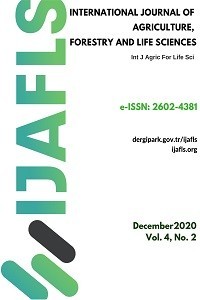FUNGICIDES EFFECT ON THE HEART ROT INFESTATIONS AT POMEGRANATE FRUIT
FUNGICIDES EFFECT ON THE HEART ROT INFESTATIONS AT POMEGRANATE FRUIT
Alternaria spp., Copper oxide, Northern Cyprus, Propiconazole + Difenoconazol, Wonderful cultivar,
___
- Barkai-Golan, R. 2001. Postharvest Diseases of Fruits and Vegetables: Development and Control. Elsevier, New York.
- Bashen, Y., Levanony, H., Or, R. 1991. Wind Dispersal of Alternaria alternate a Cause of Leaf Blight of Cotton. J. Phytopathology, 133, 225-238.
- Berbegal, M., Lopez_Cortes, I., Salazar, D., Gramaje, D., Perez-Sierra, A., Garcia-Jimenez, J., Armengol, J. 2014. First Report of Alternaria Black Spot of Pomegranate Caused by Alternaria alternatain Spain. Disease Notes, 98(5), 689.
- Chen, L. Y., Price, T. V., Park-Ng, Z. 2003. Conidial dispersal by Alternaria brassicicola on Chinese cabbage (Brassica pekinensis) in the field and under simulated conditions. Plant Pathology, 52, 536-545.
- Crites, A. M. 2004. Growing Pomegranates in Southern Nevada. University of Neveda, Cooperative Extension. 4p.
- Ezra, D., Kosto, I., Kirshner, B., Hershcovich, M., Shtienberg, D. 2014. Heart rot of pomegranate: disease aetiology and the events leading to development of symptoms. Plant Diseases. doi: http://dx.doi.org/10.1094/PDIS-07-14-0707-RE (abstract).
- Faedda, R., Granata, G., Pane, A., Evoli, M., Giudice, V.L., Lio, G.M.S., Cacciola, S.O. 2015. Heart rot and soft rot of pomegranate fruit in southern Italy. Acta Horticulturae 1144.
- Gil, M. I., Tomas-Barberan, F. A., Hess-Pierce, B., Holcroft, D. M., Kader, A. A. 2000. Antioxidant activity of pomegranate juice and its relationship with phenolic composition and processing. J. Agric. Food Chem, 48, 4581-4589.
- Haidari, M., Ali, M., Casscells, S. W., Madjid, M. 2009. Pomegranate (Punica granatum) purified polyphenol extract inhibits influenza virus and has a synergistic effect with oseltamivir. Phytomedicine, 16(12), 1127-36.
- Holland, D., Hatip, K., Bar-Ya’akov, I. 2009. Pomegranate: Botany, Horticulture and Breeding. Horticultural Reviews, Volume, 35, Edited by Jules Janick, John Wiley & Sons Inc, 127-191.
- Jurenka, J. M. T. 2008. Therapeutic Applications of Pomegranate (Punica granatum L.): A Review. Alternative Medicine Review, 13(2), 128-144.
- Kahramanoğlu, İ. and Usanmaz, S. 2016. Pomegranate Production and Marketing. CRC Press, 148p.
- Kahramanoglu, İ., Usanmaz, S., Nizam, İ. 2013. Incidence of heart rot at pomegranate fruits caused by Alternaria spp. in Cyprus. African Journal of Agricultural Research, 9(10), 905-907.
- Köhl, J. and van der Wolf, J. 2005. Alternaria brassicicola and Xanthomonas campestris pv. campestris in organic seed production of Brassicae: Epidemiology and seed infection. Note 363. Plant Research International.
- Kumar, A., Chahal, T.S., Hunjan, M.S., Kaur, H., Rawal, R. 2017. Studies of Alternaria black spot disease of pomegranate caused by Alternaria alternata in Punjab. Journal of Applied and Natural Science, 9(1), 156-161.
- Lansky, E. P., Jiang, W., Mo, H., Bravo, L., Froom, P., Yu, W., Campbell, M. J. 2005. Possible synergistic prostate cancer suppression by anatomically discrete pomegranate fractions. Invest New Drug, 23, 11-20.
- Lye, C. 2008. Pomegranate: preliminary assessment of the potential for an Australian industry. Rural Industries Research and Development Corporation of Australian Government. RIRDC Publication No. 08/153, P. 17.
- Michailides, T., Morgan, D., Quist, M., Reyes, H. 2008. Infection of pomegranate by Alternaria spp. causing black heart. Phytopathology 98:S105
- Stein, L., Kamas, J., Nesbitt, M. 2010. Pomegranates. Texas A&M Agrilife Extension. 6p.
- Timmer, L. W., Peever, T. L., Solel, Z., & Akimutsu, K. (2003). Alternaria diseases of citrus – Novel pathosystems. Phytopal. Mediterr, 42, 3-16.
- Turk, G., Sonmez, M., Aydin, M., Yuce, A., Gur, S., Yuksel, M., Aksoy, H. 2008. Effects of pomegranate juice consumption on sperm quality, spermatogenic cell density, antioxidant activity and testosterone level in male rats. Clinical Nutrition, 27, 289-296.
- Zhang, L., McCarthy, M. J. 2012. Black heart characterization and detection in pomegranate using NMR relaxometry and MR imaging. Postharvest Biology and Technology 67, 96-101.
- Yayın Aralığı: Yılda 2 Sayı
- Başlangıç: 2017
- Yayıncı: Volkan OKATAN
Hilal YILMAZ, Mevlüt GÜL, Başak AYDIN, Selcan AKKOYUN, Mehmet Emin BİLGİLİ
Jessie SABIJON, Michael Adonis SUDARIA
Demet ALTINDAL, Nüket ALTINDAL
Jessie SABIJON, Michael Adonis SUDARIA
Sahriye SÖNMEZ, Taner AKAR, Erbil DEMİR
ANALYSIS OF TECHNICAL STRUCTURE OF SMALL RUMINANT FARMS: ŞIRNAK PROVINCE SAMPLE
SOCIODEMOGRAPHIC CHARACTERISTICS OF SMALL RUMINANT FARMERS: ŞIRNAK PROVINCE SAMPLE
